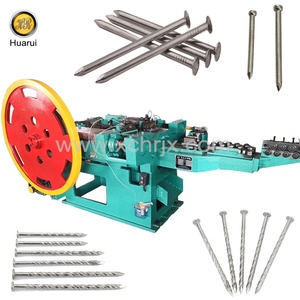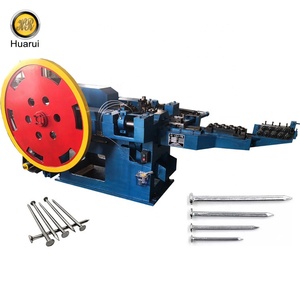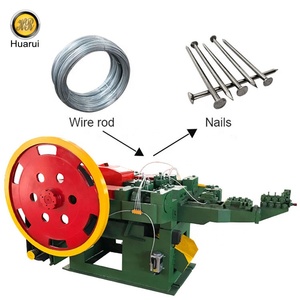
All categories
Featured selections
Trade Assurance
Buyer Central
Help Center
Get the app
Become a supplier

(1851 products available)














mechanical nail making machine are specialized machines used in industrial settings to produce nails efficiently and consistently. These machines are designed to automate the nail-making process, significantly increasing production rates compared to manual methods. mechanical nail making machine play a crucial role in the metal and metallurgy machinery industry, providing manufacturers with the capability to produce nails of various sizes and specifications to meet diverse market demands. Whether for construction, carpentry, or other applications, the precision and speed of mechanical nail making machine are indispensable in modern manufacturing environments.
There are several types of mechanical nail making machine available, each tailored to specific production needs and nail types. The most common types include automatic nail making machines, wire nail making machines, and concrete nail making machines. Automatic nail making machines are designed for high-speed production and can produce a large volume of nails in a short period. Wire nail making machines are specialized for producing nails from wire materials, offering versatility in nail size and shape. Concrete nail making machines focus on producing nails that can penetrate hard surfaces such as concrete and masonry. Each type of mechanical nail making machine is engineered to deliver optimal performance for its intended application, ensuring manufacturers can meet their production goals efficiently.
mechanical nail making machine are equipped with a range of functions and features that enhance their efficiency and usability in industrial settings. Key features include automatic feeding systems, adjustable nail length and diameter settings, and high-speed operation. Automatic feeding systems streamline the production process by continuously supplying raw materials, reducing downtime and manual intervention. The ability to adjust nail length and diameter allows manufacturers to produce nails according to specific requirements, catering to different market demands. High-speed operation is a critical feature of mechanical nail making machine, enabling the production of thousands of nails per hour, which is essential for large-scale manufacturing. Additionally, modern machines often come with user-friendly interfaces and safety mechanisms to ensure smooth and secure operation.
The construction and operation of mechanical nail making machine involve various materials that contribute to their durability and performance. The primary materials include high-grade steel and cast iron, which are used for critical components such as frames and gears. These materials are chosen for their strength and resistance to wear and tear, ensuring the longevity of the machines even under continuous operation. Tungsten carbide is often used for cutting and shaping tools within mechanical nail making machine, owing to its hardness and ability to maintain sharpness over time. Additionally, specialized lubricants and coatings are applied to reduce friction and enhance the efficiency of moving parts. The selection of materials is crucial in ensuring that mechanical nail making machine can withstand the demands of industrial production while maintaining consistent quality output.
To maximize the efficiency and lifespan of mechanical nail making machine, it is essential to follow best practices for operation and maintenance. Start by ensuring that the machine is set up on a stable, level surface to prevent operational issues. Regularly inspect and maintain the machine's components, such as lubricating moving parts and checking for wear and tear. Proper adjustment of settings, such as nail length and diameter, is crucial for achieving the desired output. Ensure that raw materials are of high quality to prevent jams and maintain consistent production. Operators should be trained to use mechanical nail making machine safely and efficiently, adhering to safety protocols to prevent accidents. By following these guidelines, manufacturers can ensure that their mechanical nail making machine operate at peak performance, delivering high-quality nails consistently.
When selecting mechanical nail making machine, it's important to consider several factors to ensure the machine meets your production needs. First, evaluate the machine's production capacity, which should align with your output requirements without compromising efficiency. Machines with adjustable settings for nail length and diameter offer versatility, allowing manufacturers to produce a range of nail sizes. Additionally, consider the type of nails you intend to produce, as some machines are specialized for wire nails, while others may focus on concrete nails. Reliability and ease of maintenance are also critical, as these factors will impact the machine's operational lifespan and downtime. Lastly, assess the machine's compatibility with your existing production infrastructure to ensure seamless integration.
Automatic mechanical nail making machine offer several benefits, including increased production speed and reduced labor costs. These machines automate the nail-making process, enabling high-volume output with minimal manual intervention. The precision of automatic machines ensures consistent nail quality, which is crucial for meeting industry standards. Additionally, automatic machines often come equipped with advanced features like automatic feeding systems and user-friendly interfaces, enhancing operational efficiency and ease of use.
To prolong the lifespan of mechanical nail making machine, regular maintenance is essential. Manufacturers should conduct routine inspections to identify and address wear and tear on critical components. Lubricating moving parts reduces friction and prevents damage, while ensuring stable and level installation minimizes operational issues. Using high-quality raw materials also contributes to smoother operation and prevents jams. Training operators to adhere to safety protocols and optimal usage practices will further enhance the machine's longevity.
Safety is paramount when operating mechanical nail making machine. Operators should be trained to understand the machine's features and safety mechanisms, such as emergency stops and protective guards. Wearing appropriate personal protective equipment, like gloves and eye protection, is necessary to prevent injuries. Ensuring that the machine is installed on a stable surface and regularly inspecting safety features will help maintain a secure working environment. Additionally, clear operational guidelines should be established to prevent accidents and ensure safe usage.
Yes, mechanical nail making machine can be customized to cater to specific production requirements. Manufacturers can opt for machines with adjustable settings for nail size and shape, allowing for the production of specialized nails. Customization options may also include enhanced automation features or modifications to accommodate unique materials. By selecting machines with customizable features, manufacturers can tailor their production processes to meet specific market demands and improve overall efficiency.
Maintaining mechanical nail making machine can present several challenges, such as wear and tear on mechanical components and the need for regular lubrication. Ensuring consistent quality of raw materials is crucial to prevent jams and maintain smooth operation. Downtime due to maintenance can impact production schedules, making efficient planning essential. Additionally, keeping up with technological advancements and updating machines to incorporate new features can be costly yet necessary for maintaining competitive production capabilities. Regular training for operators and maintenance personnel can help address these challenges and ensure optimal machine performance.